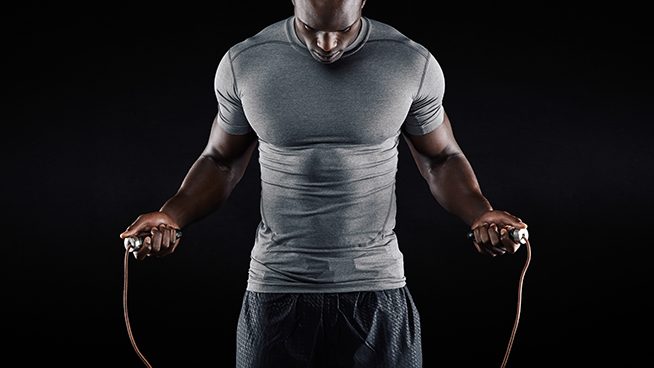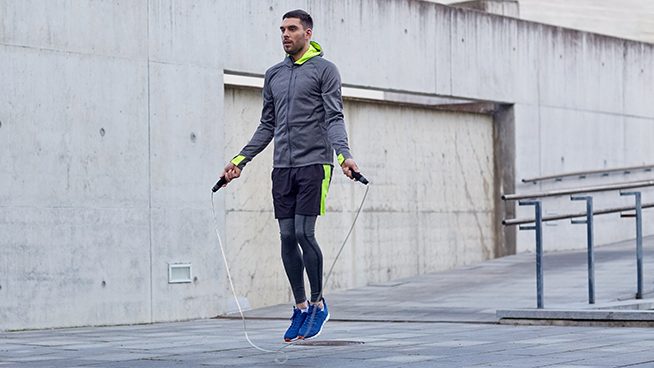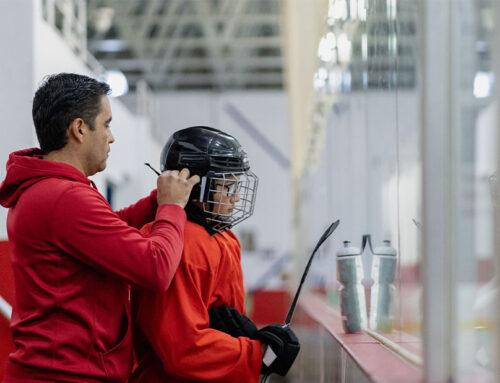Why Jumping Rope is a Must for Athletes
Jumping rope is an exercise that a lot of us spent a few days on in PE during elementary school and then forgot all about. But it is an extremely important exercise for athletes! Why is it so important? A jump rope an incredibly inexpensive tool that does not require special equipment or facilities. You can find one for $2 or $3. With that inexpensive piece of equipment you are able to train your endurance, burn a lot of calories, strengthen the bones of your lower body, strengthen the muscles of your shins, ankles and feet, work on your foot speed, and increase your athleticism.
Let’s talk about some of these. Essentially, jumping rope involves jumping up and down repetitively. This means that the weight-bearing bones in your body have to become stronger to support this. This could be an important tool for preventing lower-body stress fractures that are associated with training and sports.
We don’t do a lot for the muscles of our shins, ankles and feet beyond calf raises in the weight room. Because of this, athletes get shin splints, plantar fasciitis and Achilles tendon strains. The act of jumping rope can strengthen these muscles (and tendons) and help to prevent injuries.
Jumping rope, especially when you move into more advanced exercises will increase your athleticism and foot speed. This is important for every athlete regardless of the sport.
All of this for a few dollars in equipment! Having discussed the benefits, we’re going to cover four exercises for the jump rope that will give you a solid foundation for learning more advanced exercises. Then this article will discuss how to use it as part of a warm-up or as part of a conditioning workout.
Jump Up and Down
For me, this is the default exercise and one everyone should master first. First, make sure your rope is the correct length: It should go up to your armpits. This means you may have to wrap it around your hands, loosely, a few times to make this happen. Too short or too long and the exercise is too difficult.
Once you have the length for the rope, stand up and hold a rope handle in each hand. Your hands should be at your sides, roughly at hip level. Keep your knees soft, but perform the exercise using your ankles (this is not a jump from your knees!) Begin with the rope behind your body. Rotate it so that it moves behind you, over you and in front of you. As it approaches the ground, hop up using your ankles so that the rope travels under your feet. Repeat this motion, attempting to establish a rhythm.
Jump Side to Side
Once you can jump up and down for 30-60 seconds continuously it’s time to think about increasing the complexity. Begin this exercise exactly like the jump up and down exercise. In fact, I find that it is helpful to perform the jump up and down exercise for 10-20 repetitions before trying anything else.
Now, instead of jumping up and down you will jump from one side to the other as the rope rotates in front of the body. You are still jumping over the rope, but this is occurring as you move from side to side. Again, this should be an efficient movement from your ankles.
Jump Forward and Backward
Once you can jump from side to side for 30-60 seconds continuously, it’s time to make things more difficult. Begin this exercise exactly like the jump up and down exercise, in fact begin with that exercise for 10-20 repetitions. Now, instead of jumping up and down you will hop forward and backward over the rope. Again, this is done by hopping from your ankles.
Jump on one foot
Any of the above jumps can be done on one foot. I would begin with the up and down jump, then try side to side, then try forward and backward. When using one foot, pick the other one up off the ground. Begin this variation with a low volume (5-10 repetitions on each foot) so that you have a chance to get used to it; this is a lot more difficult than you think it will be!
The above four tools will build a foundation you can use to learn much more complex exercises. They can also be all you need, as I’ll show you below.
Jump Rope as Warm-Up
A lot of us are used to some type of pseudo-aerobic exercise during the first part of the warm-up. This could be a 400-meter jog, riding the stationary bike for a few minutes, the rowing machine, etc. Instead, consider five minutes of jumping rope. The rope will increase heart rate, get blood moving throughout the body, warm the joints, burn calories and develop the foot speed/athletic qualities that we want. This is a great way to start the warm-up before moving to mobility drills, technique drills or light sets. I think this is especially appropriate before athletic practices; for example, five minutes of jumping rope before beginning basketball practice.
Jump Rope as Conditioning
This can serve as a great tool for metabolic conditioning sessions. I do not like making it an aerobic exercise (i.e., jump for 20 minutes), but it lends itself to being done for finite intervals (for example, jump for 60 seconds). Because it requires little equipment and space, it lends itself to circuit-style workouts. For example:
- Up and down, 60 seconds
- Kettlebell Swings, 60 seconds,
- Plank, 60 seconds; Repeat three times
- Side to side, 60 seconds
- Lunges, 60 seconds
- Side Planks, 30 seconds each side; Repeat three times
- Forward and backward, 60 seconds
- Inchworms, 60 seconds
- Reverse Crunches, 60 seconds; Repeat three times
- One foot, up and down, 30 seconds each foot
- Push-Ups, 60 seconds
- Crunches, 60 seconds; Repeat three times
- One foot, side to side, 30 seconds on each foot
- Bear Crawls, 60 seconds
- Russian Twists, 60 seconds; Repeat three times
The above workout hits every muscle in the body, involves 15-20 minutes of activity and only requires a kettlebell and a rope.
READ MORE:
- Todd Durkin’s World-Class Workouts: Get in Shape With a Jump Rope
- 4 Jump Rope Drills for Speed, Agility and Quickness
- Five Reasons to Go Back to Basics With the Jump Rope
RECOMMENDED FOR YOU
MOST POPULAR
Why Jumping Rope is a Must for Athletes
Jumping rope is an exercise that a lot of us spent a few days on in PE during elementary school and then forgot all about. But it is an extremely important exercise for athletes! Why is it so important? A jump rope an incredibly inexpensive tool that does not require special equipment or facilities. You can find one for $2 or $3. With that inexpensive piece of equipment you are able to train your endurance, burn a lot of calories, strengthen the bones of your lower body, strengthen the muscles of your shins, ankles and feet, work on your foot speed, and increase your athleticism.
Let’s talk about some of these. Essentially, jumping rope involves jumping up and down repetitively. This means that the weight-bearing bones in your body have to become stronger to support this. This could be an important tool for preventing lower-body stress fractures that are associated with training and sports.
We don’t do a lot for the muscles of our shins, ankles and feet beyond calf raises in the weight room. Because of this, athletes get shin splints, plantar fasciitis and Achilles tendon strains. The act of jumping rope can strengthen these muscles (and tendons) and help to prevent injuries.
Jumping rope, especially when you move into more advanced exercises will increase your athleticism and foot speed. This is important for every athlete regardless of the sport.
All of this for a few dollars in equipment! Having discussed the benefits, we’re going to cover four exercises for the jump rope that will give you a solid foundation for learning more advanced exercises. Then this article will discuss how to use it as part of a warm-up or as part of a conditioning workout.
Jump Up and Down
For me, this is the default exercise and one everyone should master first. First, make sure your rope is the correct length: It should go up to your armpits. This means you may have to wrap it around your hands, loosely, a few times to make this happen. Too short or too long and the exercise is too difficult.
Once you have the length for the rope, stand up and hold a rope handle in each hand. Your hands should be at your sides, roughly at hip level. Keep your knees soft, but perform the exercise using your ankles (this is not a jump from your knees!) Begin with the rope behind your body. Rotate it so that it moves behind you, over you and in front of you. As it approaches the ground, hop up using your ankles so that the rope travels under your feet. Repeat this motion, attempting to establish a rhythm.
Jump Side to Side
Once you can jump up and down for 30-60 seconds continuously it’s time to think about increasing the complexity. Begin this exercise exactly like the jump up and down exercise. In fact, I find that it is helpful to perform the jump up and down exercise for 10-20 repetitions before trying anything else.
Now, instead of jumping up and down you will jump from one side to the other as the rope rotates in front of the body. You are still jumping over the rope, but this is occurring as you move from side to side. Again, this should be an efficient movement from your ankles.
Jump Forward and Backward
Once you can jump from side to side for 30-60 seconds continuously, it’s time to make things more difficult. Begin this exercise exactly like the jump up and down exercise, in fact begin with that exercise for 10-20 repetitions. Now, instead of jumping up and down you will hop forward and backward over the rope. Again, this is done by hopping from your ankles.
Jump on one foot
Any of the above jumps can be done on one foot. I would begin with the up and down jump, then try side to side, then try forward and backward. When using one foot, pick the other one up off the ground. Begin this variation with a low volume (5-10 repetitions on each foot) so that you have a chance to get used to it; this is a lot more difficult than you think it will be!
The above four tools will build a foundation you can use to learn much more complex exercises. They can also be all you need, as I’ll show you below.
Jump Rope as Warm-Up
A lot of us are used to some type of pseudo-aerobic exercise during the first part of the warm-up. This could be a 400-meter jog, riding the stationary bike for a few minutes, the rowing machine, etc. Instead, consider five minutes of jumping rope. The rope will increase heart rate, get blood moving throughout the body, warm the joints, burn calories and develop the foot speed/athletic qualities that we want. This is a great way to start the warm-up before moving to mobility drills, technique drills or light sets. I think this is especially appropriate before athletic practices; for example, five minutes of jumping rope before beginning basketball practice.
Jump Rope as Conditioning
This can serve as a great tool for metabolic conditioning sessions. I do not like making it an aerobic exercise (i.e., jump for 20 minutes), but it lends itself to being done for finite intervals (for example, jump for 60 seconds). Because it requires little equipment and space, it lends itself to circuit-style workouts. For example:
- Up and down, 60 seconds
- Kettlebell Swings, 60 seconds,
- Plank, 60 seconds; Repeat three times
- Side to side, 60 seconds
- Lunges, 60 seconds
- Side Planks, 30 seconds each side; Repeat three times
- Forward and backward, 60 seconds
- Inchworms, 60 seconds
- Reverse Crunches, 60 seconds; Repeat three times
- One foot, up and down, 30 seconds each foot
- Push-Ups, 60 seconds
- Crunches, 60 seconds; Repeat three times
- One foot, side to side, 30 seconds on each foot
- Bear Crawls, 60 seconds
- Russian Twists, 60 seconds; Repeat three times
The above workout hits every muscle in the body, involves 15-20 minutes of activity and only requires a kettlebell and a rope.
READ MORE:
- Todd Durkin’s World-Class Workouts: Get in Shape With a Jump Rope
- 4 Jump Rope Drills for Speed, Agility and Quickness
- Five Reasons to Go Back to Basics With the Jump Rope












